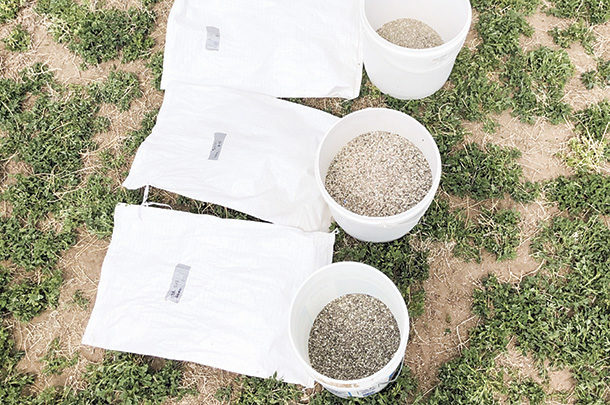Fertilizer bills can be some of the largest bills on the farm. Applying the precise amounts at the right time and in the right way can drastically influence farm profits.
Like most inputs on the farm, too little or too much can hurt the bottom line. The most common sources for fertilizer recommendations are from private and public soil testing labs, crop advisers, fertilizer dealers and university extension services.
Private labs are sometimes criticized for being too liberal and public labs for being too conservative in fertilizer recommendations. Given this, ideal and economic fertilizer recommendations can be difficult to discern.
While both public and private advisers actively try to avoid or correct nutrient deficiencies to help growers thwart yield and profit loss, these efforts can sometimes lead to excessive and unprofitable fertilizer recommendations.
Unbiased comparisons of the most common fertilizer recommendations from public and private sources are needed to help growers improve their nutrient management. This need prompted a set of on-farm research trials in Utah to investigate how various fertilizer recommendations perform.
On-farm experiment procedures
A large team of Utah State University Extension faculty established an experiment in 2021 at 12 fields across the state of Utah in corn, alfalfa and small grains to test and compare the fertilizer recommendations of five labs.
The recommendations tested were from two public labs (Utah State University and University of Idaho) and three private labs located in the western U.S. A single, large composite soil sample to 12 inches from each field was dried, ground, split and sent to each of the labs for analysis.
The macronutrient and micronutrient rates recommended by each lab were then applied in four replications at each of the 12 fields. A control with no fertilizer was also included.
All fertilizer products were broadcast-applied in the early spring of 2021 as dry granular products due to difficulty in applying liquid fertilizers to small plots. Fertilizer products were selected to isolate nutrients.
For example, triple super-phosphate and ammonium nitrate were used to isolate phosphorus and nitrogen so precise amounts of various nutrients could be applied together. The 12 fields represented a range of soil organic matter levels (0.9% to 3.1%) and a range of soil texture (gravelly sandy loam to silty clay loam – Table 1).

How much did recommendations vary?
Most advisers and growers understand that fertilizer recommendations vary by soil testing labs, but by exactly how much? Our results showed that soil nutrient levels varied among labs.
This was expected, as a single soil sample will yield slightly different analysis results because the same soil cannot be analyzed twice. Most measured soil nutrient concentrations of potassium, magnesium, zinc, iron, manganese and copper (K, Mg, Zn, Fe, Mn, Cu) varied less than 15% among labs. However, four others – nitrogen, phosphorus, calcium and boron (N, P, Ca, B) – varied by about 33%, and sulfur (S) varied by 62% among labs.
Variations in soil nutrient concentrations caused some differences in the amount of fertilizer recommended (pounds per acre) from each lab, but most of the recommendation differences were based on different critical values or calibrations that each lab uses to set recommendations.
For example, the three macronutrients (N, P and K) varied across the 12 fields by an average of 118%, 66% and 140% among labs. Micronutrients were more often recommended by private labs than public labs and subsequently varied by more than 200% among the five labs.
Only one private lab recommended magnesium in one field and copper in four of the 12 fields. Zinc, manganese, sulfur and boron were commonly recommended. No labs recommended calcium or iron.
Differences in the costs of recommendations also varied among labs. The two public labs cost an average of $110 to $180 per acre across the 12 fields, and the three private labs varied from $150 to $525 per acre.
The difference in the fertilizer recommendation costs among the five labs ranged from $200 to $80 per acre across the 12 fields.
How did recommendations perform?
Results from 2021 indicate there was little to no difference statistically in crop yield between the five fertilizer recommendations and the control, where no fertilizer was applied.
Across the four cornfields, there was no statistical difference in yield between treatments. We intended to keep all nitrogen off the control plots, but this was not possible due to fertigation of nitrogen by cooperating growers.
Thus, all the cornfields had nitrogen applied to all plots through fertigation and is likely why we saw no improvement in yield with the five recommendations that included nitrogen. However, results still indicate that no other nutrient besides nitrogen was needed to improve corn yield.
The five fertilizer recommendations also had no effects on alfalfa yield at five fields or at two of the three small-grain fields. At one small-grain field, one private and one public lab recommendation increased small-grain yield by 1 ton of dry matter per acre above the non-fertilized control.
In addition to yield, forage quality is being measured at all the sites and will be utilized to calculate a return to fertilizer investment for each treatment and field. These results will likely show large opportunities for improved fertilizer recommendations.
What can be concluded so far?
Only one of 12 fields responded to fertilizer. This does not mean fertilizer can always be withheld on these or similar fields.
Many nutrients can have long-lasting impacts on crop production for several years. It does mean there is opportunity to improve public and private fertilizer recommendations.
It also demonstrates vast differences in fertilizer recommendations and costs among private and public labs, and points toward the need for better synchrony among recommendations.
Most of these trials will be monitored again in 2022, so please stay tuned. In the meantime, take a careful look at your fertilizer recommendations to ensure they are improving your net returns.











